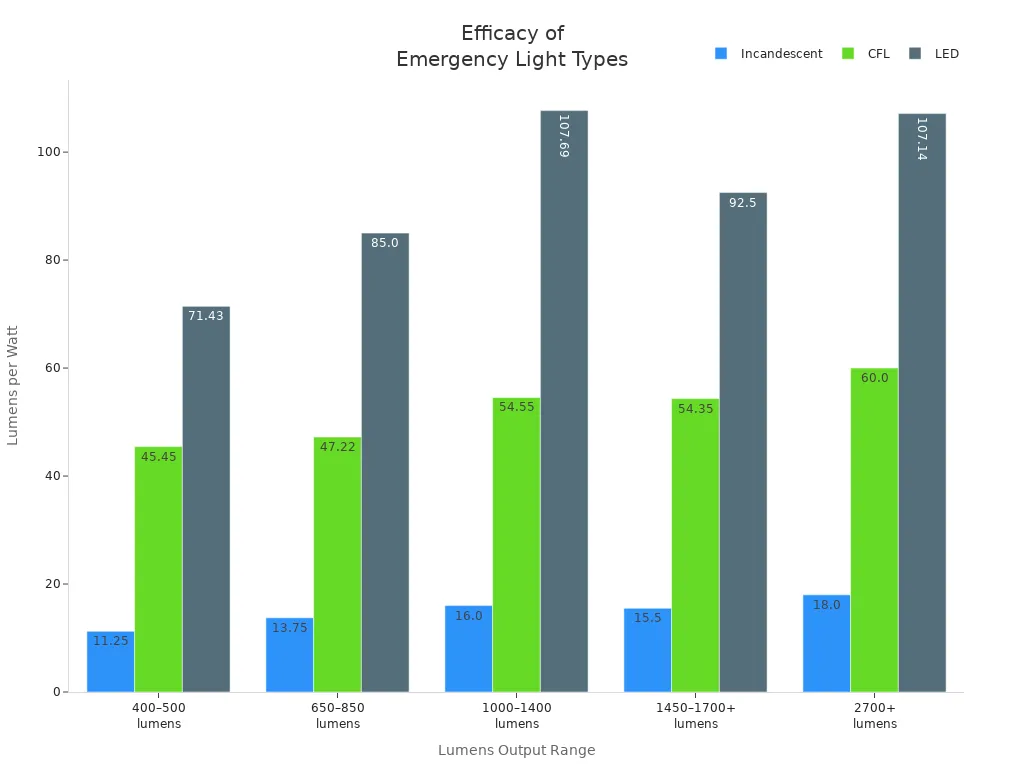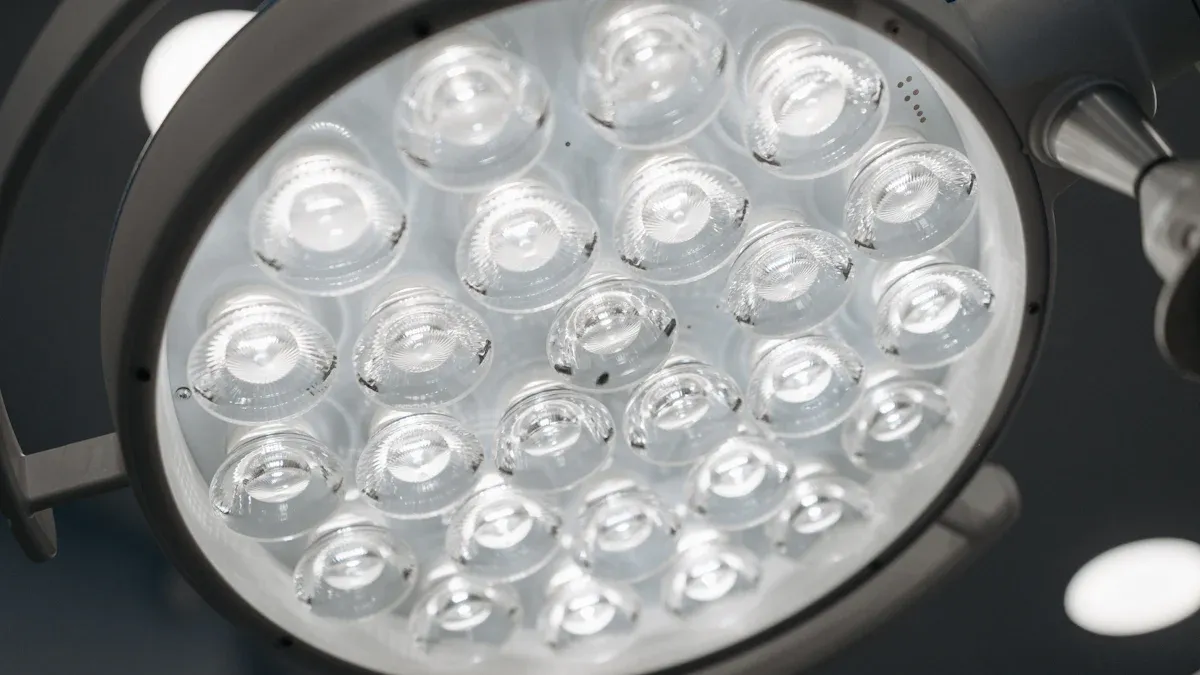Advanced LED Lighting Technology and How Modern Emergency Lights Enhance Safety and Efficiency

Advanced led lighting is changing how people stay safe in emergencies. You need lights that turn on fast and work well when time matters. The emergency clean lighting fixtures market will be worth $2.5 billion by 2025. This shows more people trust LED products because they last long and save energy. Advanced led lighting lasts longer than old systems. It needs less fixing and has smart features. This makes it a great choice for homes and public places. Companies now make products with built-in sensors and remote checks. This helps show why good lighting is important in emergencies. About Us pages and Soalr Light solutions talk about these new ideas. They show how these lights help keep people safe in real life.
Key Takeaways
Advanced LED emergency lights use up to 75% less energy. They give bright light right away when the power goes out. LED lights last much longer than old bulbs. This means you do not need to fix or replace them as often. You save a lot of money on repairs. Smart LED systems let you check lights in real time. They can test themselves and be controlled from far away. This keeps emergency lights ready and working well. Battery backup lets emergency lights stay on for at least 90 minutes. This helps people leave safely when the power is out. Using advanced LED lighting helps you follow safety rules. It also makes it easier to see and saves you money. You can get government rebates and pay less for energy.
Advanced LED Lighting Benefits
Energy Efficiency
You want emergency lights that use less energy but shine bright. Advanced LED lighting is very good at saving energy. For example, an incandescent bulb needs 60 watts for 800 lumens. An LED bulb only needs about 8 watts for the same light. This saves you 52 watts each time you use an LED. You pay less for electricity and your building stays cooler.
Lumens Output Range | Incandescent Power (W) | CFL Power (W) | LED Power (W) |
|---|---|---|---|
400 – 500 | 40 | 8 – 12 | 6 – 7 |
650 – 850 | 60 | 13 – 18 | 7 – 10 |
1000 – 1400 | 75 | 18 – 22 | 12 – 13 |
1450 – 1700+ | 100 | 23 – 30 | 14 – 20 |
2700+ | 150 | 30 – 55 | 25 – 28 |
This table shows that LED lights need fewer watts for the same brightness. You get more light for each watt with LEDs. Some LED lights give up to 120 lumens per watt. Incandescent bulbs do not come close to this. With advanced LED technology, you can add smart controls. These controls help you save even more energy. They change the light when people leave or when it is bright outside.

Tip: If you switch to advanced LED lighting, you can use 75% less energy for lights. This saves money and helps the planet.
Long Lifespan
You want emergency lights that last a long time. Advanced LED lighting works much longer than old types. Most advanced LED emergency lights last at least 25,000 hours. Some LED strobe lights last up to 50,000 hours. LEDs last longer because they are strong and do not get too hot.
You do not have to replace them as often. You also spend less time fixing them. LED lights do not have thin wires inside, so they do not break easily. They can handle bumps and shakes better than other bulbs. This makes your emergency lights work well, even in hard times.
Advanced LED lighting can last up to 50,000 hours, so you do not need to change them often.
LEDs can take hits and shakes, so you fix them less.
Using less energy means less heat, which helps them last longer.
Smart LED systems can tell you if there is a problem before it gets worse, so you save time and money.
LED lights may cost more at first, but you save money later because you do not have to replace or fix them as much.
Immediate Illumination
In an emergency, you need lights to turn on right away. Advanced LED lighting gives full brightness as soon as you need it. When the power goes out, LED emergency lights turn on fast with solid-state transfer switches. There is no waiting, so you get bright light right away.
Aspect | Supporting Details |
|---|---|
Instant-On Feature | LED emergency lights turn on instantly during power outages via solid-state transfer switches, ensuring no delay in illumination. |
Illumination Duration | Battery backup guarantees at least 90 minutes of continuous operation after power loss. |
Brightness and Coverage | High lumen output (e.g., 209.5 lumens), adjustable twin heads for directing light, coverage up to 60 feet, providing bright, steady illumination. |
Regulatory Compliance | NFPA 101 Life Safety Code mandates automatic transfer within 10 seconds and minimum illumination levels (1 footcandle initial, 0.1 footcandle at floor level). |
Maintenance Features | Built-in test switch and charge indicator ensure system readiness and reliability. |
These lights keep you safe by turning on right away. You can point the light where you need it, like in halls or stairs. Battery backup keeps the lights on for at least 90 minutes. This meets safety rules and gives you time to get out safely. Test switches and charge lights help you check if your system is ready.
Note: Fast, bright lighting during a power outage stops accidents and helps everyone find the way out quickly.
LED Emergency Lights Features

Smart Integration
You can control led emergency lights with smart features now. Modern systems let you watch your lights in real time. They send alerts if something is wrong. Energy-saving modes help save power when lights are off. The system checks itself every month and does a big test once a year. This keeps your emergency lights ready all the time.
Here are some smart integration features you might see:
Real-time monitoring and alerts help you find problems fast.
Energy-saving modes use less power when lights are not on.
Automated self-testing makes sure your lights work when needed.
You can link smart led emergency lights to building systems. This lets you check battery life, get alerts, and control lights from your phone or computer. Remote management helps you find problems quickly and plan repairs before they get worse. You can control up to 500 lights with one gateway, so big buildings stay safe.
Tip: Smart controls let you plan tests, dim lights, and get updates, so you always know your led emergency lights are ready.
Battery Backup
Battery backup is very important for led emergency lights. These lights switch to battery power right away if the main power goes out. You get at least 90 minutes of light, which meets safety rules like UL 924 and NFPA 101. Most led lights use sealed lead acid or Nickel Cadmium batteries. Ni-Cd batteries last longer and are smaller.
Led emergency lights with battery backup turn on fast during a power outage. You do not need extra wires, so putting them in is easy. Self-testing and remote checks help you keep up with monthly and yearly tests. This makes it easier to follow safety rules and keep your building safe.
Note: Always check your battery backup to make sure your led emergency lights will work in an emergency.
Durability
You want led emergency lights that work in tough places. Good materials and smart design make these lights strong and dependable. Weather-resistant cases protect led lights from rain, snow, heat, and cold. Epoxy lenses cover the led parts and protect them from bumps, shocks, and chemicals.
Epoxy resin makes a strong cover around the led, keeping out water, dust, and dirt.
These lenses stay clear, so your lights stay bright and do not turn yellow.
Epoxy also helps with heat and blocks UV rays, so your led emergency lights last longer.
Cleaning your lights and putting them in the right way helps them last even more. You can count on these lights to work, even in hard places.
Emergency Lighting Systems Impact
Enhanced Visibility
Emergency lighting systems help people see well in emergencies. These systems use advanced LED technology to make things bright and clear. This helps everyone find exits fast when there is danger. Lights are put in smart places so there are no dark spots. Stairs, hallways, and escape paths stay bright and safe. In hospitals and public places, good lighting helps doctors and staff do their jobs. The white light from LEDs shows colors well, so people can see clearly. Some lights turn on or get brighter when someone moves nearby. This makes places safer and helps drivers see better on roads. Good lighting stops confusion and panic when something bad happens.
Tip: Put emergency lights every 30 feet in long hallways. This keeps the area bright and follows safety rules.
Compliance
You have to follow safety rules when you put in emergency lighting. These systems help you meet rules from OSHA, NFPA 101, and local codes. Here are some important things to remember:
Emergency lighting must turn on by itself if the power goes out. It should stay on for at least 90 minutes.
Hospitals must test their lights often to keep people safe.
Building and fire codes set rules to keep people healthy and safe.
Local rules might ask for more, so always check with your city.
Some lights let you test them from far away and see if they work. You can get updates about your lights in real time. If you connect lights to fire alarms, they all turn on together. This helps you follow the rules and keep everyone safe.
Cost Reduction
Switching to advanced LED emergency lights saves you a lot of money. LEDs use much less energy than old lights and last much longer. You pay less for power and do not have to fix lights as often. The table below shows how much you can save:
Cost Reduction Aspect | Documented Figures / Examples |
|---|---|
Energy Cost Reduction | 30-50% monthly energy cost savings after upgrading to LED systems |
Maintenance Cost Reduction | Up to 75% reduction in maintenance costs |
Payback Period / ROI | Typical payback period of 2-3 years through operational savings |
LED Energy Efficiency | LED uses 75% less energy than traditional lighting and lasts 15 times longer |
Government Incentives | Federal tax deductions of $0.54–$1.13 per square foot (2023-2024), increasing with wage requirements |
Utility Rebates | Up to $249 per LED fixture via point of sale, prescriptive, and custom rebates |
You can also get money back from the government and your power company. This makes it cheaper to buy new lights. In hospitals, public places, and important buildings, these savings help you spend money on other safety needs. Advanced emergency lights keep people safe and help you save money and energy.
Emergency Vehicles and LED Tunnel Lamps

High-Output LEDs
Emergency vehicles use led emergency lights to help keep roads safe. High-output LEDs are very bright and clear. They shine through fog, rain, and snow. These lights turn on right away, so you get light fast. This is important when every second matters. The P4 LEDs, like the CP41A and CP41B, are made for emergency vehicles. They use amber and red colors. These colors help drivers see you from far away. The table below shows how these LEDs work:
Product Line | LED Type | Application | Color | Wavelength (nm) | Max Current (A) | Size (mm) |
|---|---|---|---|---|---|---|
P4 LEDs | CP41A & CP41B | Emergency Vehicle Lighting | Amber/Red | 584 - 637 | 0.07 | 7.6 x 7.6 |
These led emergency lights use less power and last a long time. You do not need to change them often. They are strong and can handle bumps and shakes. This is good for vehicles that move a lot. These lights help you follow safety rules and make roads safer.
Programmable Signals
Programmable led emergency lights help emergency vehicles warn other drivers fast. These lights can flash in different ways or change colors. You can pick the pattern or color for each situation. Programmable signals help drivers see you before you get close. Studies show that in-car warnings and geofencing alerts help drivers slow down and move over faster. This lets emergency vehicles get through traffic with fewer problems. You lower the chance of accidents and help emergency teams do their jobs better. You can also change how bright the lights are and how long they flash.
Tip: Use programmable led emergency lights to help drivers see you and keep everyone safe on the road.
Specialized Applications
Led tunnel lamps are needed for places like tunnels and underground roads. These lights give bright, even light so drivers can see well. When you switch old lights for led tunnel lamps, you see better and have less glare. This helps stop accidents and keeps roads safe. Here are some ways led tunnel lamps make things safer:
They give even light, so you can see clearly in tunnels.
Advanced modules control how bright and wide the light is, making dangerous spots safer.
Accident numbers go down when you use led tunnel lamps in tunnels.
You can watch the area better and spot dangers quickly.
These lamps meet tough rules for color and brightness.
Drivers do not get as tired and can see things in the road more easily.
Led tunnel lamps help in emergencies by keeping exits and paths bright.
Smart controls change the light based on traffic and emergencies.
Emergency vehicles get steady light, so they can respond better.
You help emergency teams and make places safer.
You can trust led emergency lights and led tunnel lamps to keep people safe in any situation. They help you follow safety rules, save energy, and make roads safer for everyone.
Innovations and Future Trends
IoT and Automation
IoT-enabled emergency lighting systems help make buildings safer. Each light connects to a main system. You get updates and alerts if something is wrong. The system checks each light by itself and tells you about problems. This means you do not have to check every light by hand. It saves time and helps you fix things before they get worse. In big buildings, you can do 30% less work on repairs. Each light shows its own status, so you know which one needs help. Data centers and hospitals use these systems to keep lights ready all the time. Led tunnel lamps with IoT features make tunnels and underground places safer and have less downtime.
Tip: Begin in areas that need lots of care. Use wireless, self-reporting led tunnel lamps to make a safety map for your building.
Eco-Friendly Solutions
Choosing eco-friendly emergency lighting helps the earth. Many companies use recyclable materials like aluminum, copper, and strong plastics in led tunnel lamps. The lights are made so you can fix or upgrade them instead of throwing them away. Some companies take back old lights to recycle them. New led tunnel lamps use less energy and can work with solar or wind power. Smart sensors change the light when people are near or when there is more sunlight. This saves energy and lowers pollution. Power over Ethernet (PoE) lets you use low-voltage power for led tunnel lamps, making them safer and better.
Using recyclable materials helps the earth and keeps things going in a circle.
Modular designs help lights last longer and make less trash.
Smart controls and green energy make things work better.
Cost and Efficiency Advances
New chips and better parts make led tunnel lamps work better. High-efficiency drivers and chips give more light but use less power. Better heat sinks and lenses keep lights cool and bright for a long time. These changes help you pay less for energy and repairs. The table below shows some important upgrades:
Feature | Benefit |
|---|---|
More light, less power | |
Compact device size | Flexible installation |
Better thermal management | Longer lifespan, fewer replacements |
Circuit protection devices | Fewer failures, lower repair costs |
In the next five years, prices will drop and performance will get better. New lithium-ion batteries and hybrid power systems make led tunnel lamps work well during blackouts. Government rebates and programs help you save money when you buy new lights. This means you get better lights, spend less, and keep people safer with each new led tunnel lamp.
When you switch to advanced LED emergency lighting, you get many benefits.
You can see better in emergencies because the lights turn on fast and work well.
You use less energy and spend less money fixing lights because they last a long time and have smart controls.
You follow safety rules and make sure your building is always ready for anything.
Keep up with new technology. Check your lighting system often and ask experts for help to keep your building safe.
FAQ
What makes LED emergency lights better than traditional lights?
LED emergency lights use less energy and last much longer. They turn on right away and shine bright. You do not have to fix them as often. These lights follow strict safety rules. You can count on them to work when you need them.
How often should you test your LED emergency lighting system?
Test your LED emergency lights every month. Many smart LED systems check themselves and send alerts if there is a problem. Doing regular checks helps you follow the rules and keeps your building safe.
Can you install LED emergency lights in outdoor areas?
Yes, you can put LED emergency lights outside. Pick weather-resistant models with strong epoxy lenses. These lights can handle rain, snow, and hot or cold weather. Your exits and walkways stay safe no matter the weather.
Do LED emergency lights work during a power outage?
LED emergency lights switch to battery power right away if the power goes out. You get at least 90 minutes of light, which meets safety codes. Always check your battery backup so your lights will work when needed.
Are there rebates or incentives for upgrading to LED emergency lighting?
You can get money back from your power company and tax breaks from the government. These programs help you pay less at first. Ask your local provider or a lighting expert about deals you can get now.

